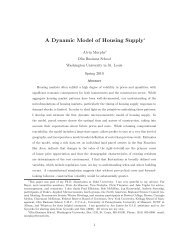Shopping Externalities and Self Fulfilling Unemployment Fluctuations*
Shopping Externalities and Self Fulfilling Unemployment Fluctuations*
Shopping Externalities and Self Fulfilling Unemployment Fluctuations*
Create successful ePaper yourself
Turn your PDF publications into a flip-book with our unique Google optimized e-Paper software.
5 Sentiments <strong>and</strong> the Great RecessionIn this section, we bring our theory to the data. First, we calibrate the parameters ofthe model so as to match US data on the transition of workers between employment <strong>and</strong>unemployment <strong>and</strong> on the di¤erence in shopping behavior between employed <strong>and</strong> unemployedworkers. We …nd that, given our baseline calibration, the model admits multiple equilibria<strong>and</strong> that there exists a 1-2 Regime Switching Equilibrium. Second, we use our calibratedmodel with regime switches to ask whether the behavior of the US economy during theGreat Recession (i.e. the recession that took place between December 2007 <strong>and</strong> June 2009)<strong>and</strong> its aftermath can be explained as the response to a negative sentiment shock. We …ndthat, given our baseline calibration, the model suggests that a negative sentiment shock is apromising explanation of the recent behavior of the US economy.5.1 Calibration StrategyThe …rst step of the analysis is to calibrate the parameters of the model with regime switches.The parameters describing preferences are the discount factor, , <strong>and</strong> the exponent on theBJ good in the worker’s utility function, . Technology is described by the productivity oflabor in the market, y e , <strong>and</strong> at home, y u , <strong>and</strong> by the rate of transformation of the AD <strong>and</strong>the BJ goods in the market, c, <strong>and</strong> at home, r. The search <strong>and</strong> bargaining frictions in thelabor market are described by the vacancy cost, k, the destruction rate, , the bargainingpower of workers, , <strong>and</strong> the matching function M which we assume to have the CES formM(u; v) = uv(u + v ) 1= . The search frictions in the product market are described by theprobability that an unemployed worker searches twice, u , the probability that an employedworker searches twice, e , <strong>and</strong> by the matching function N, which we assumed to be of theform N(b; s) = minfb; sg. Finally, the evolution of sentiments is described by the switchingprobabilities, GB (u) <strong>and</strong> BG (u), <strong>and</strong> by the jump in the …rm’s value conditional on a switchfrom the good to the bad regime, C GB (u; J). For the sake of simplicity, we restrict attentionto GB (u) <strong>and</strong> BG (u) that are independent of u, <strong>and</strong> let C GB (u; J) = , < 0.We calibrate the parameters of the model by matching moments of the model (evaluatedat the steady state associated with the optimistic regime) with empirical moments of the USdata from the years 1987-2007 (which we interpret as a period during which the US economywas in the optimistic regime). We choose the cost of a vacancy, k, <strong>and</strong> the job destructionrate, , so that the average of the monthly unemployment to employment transition rate(henceforth, UE rate) <strong>and</strong> the average monthly employment to unemployment transitionrate (EU rate) are the same in the data <strong>and</strong> in the optimistic regime of the model. We32
















